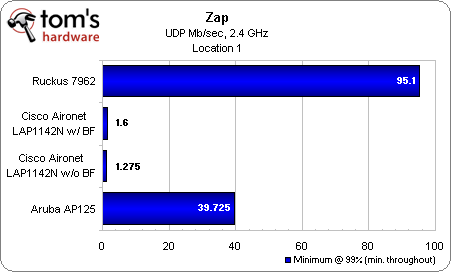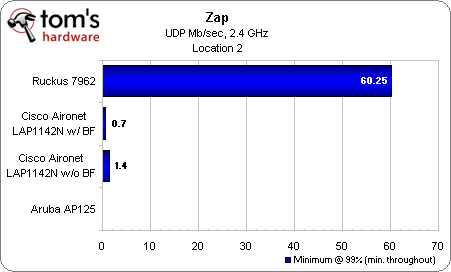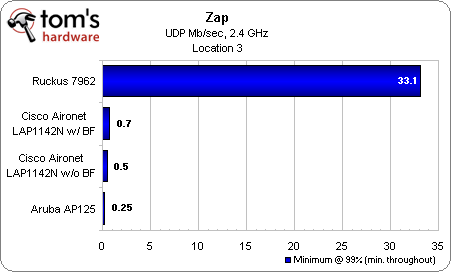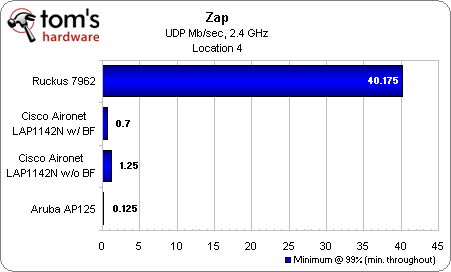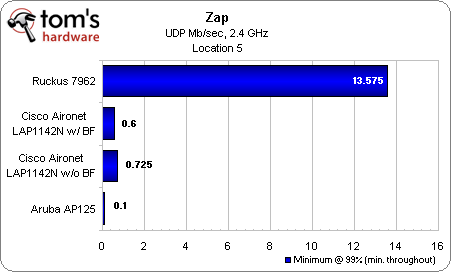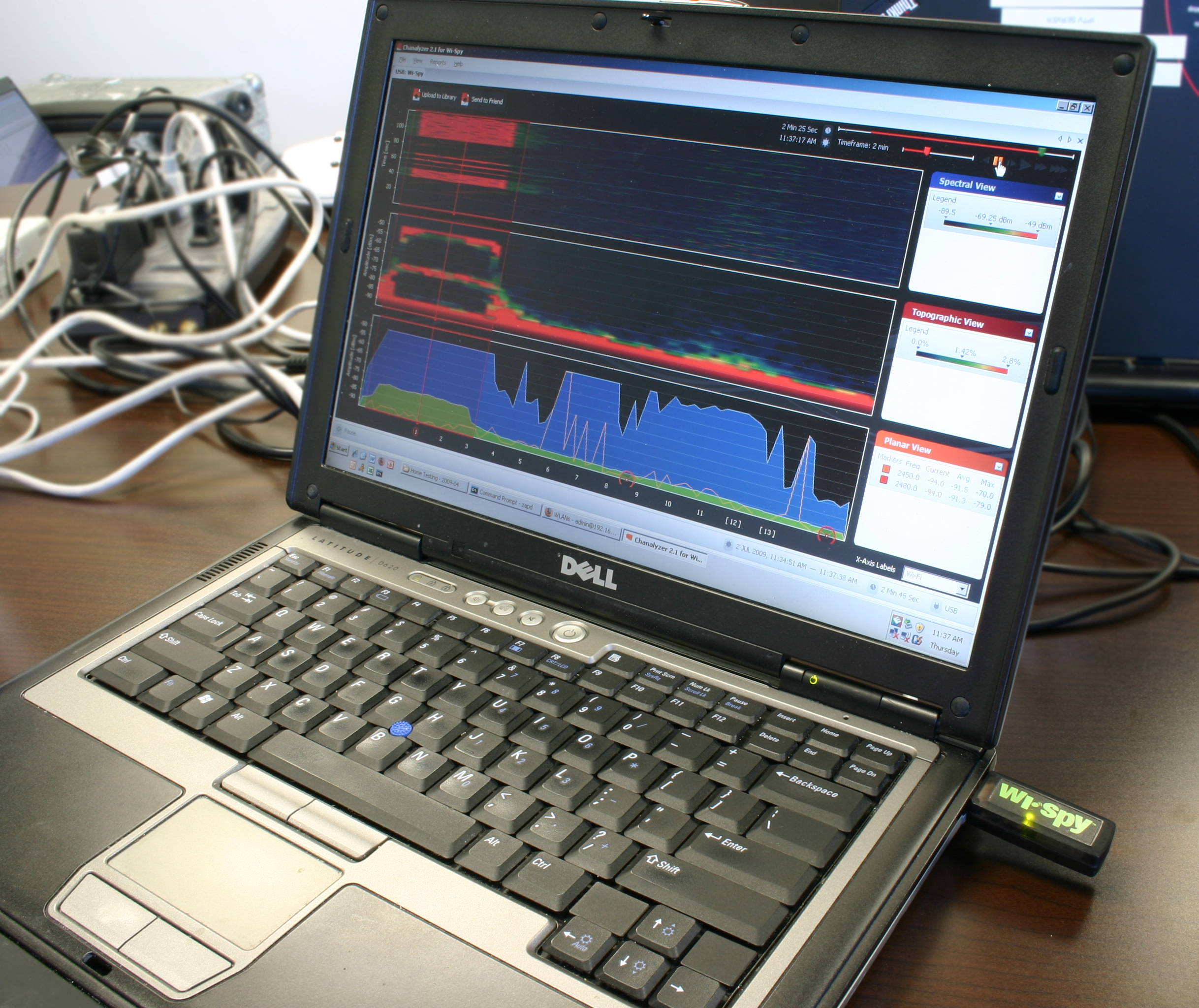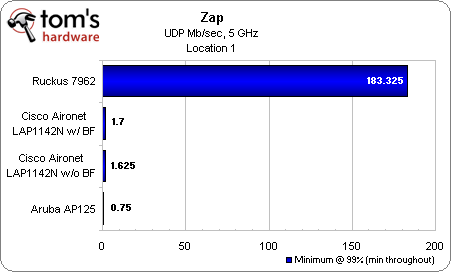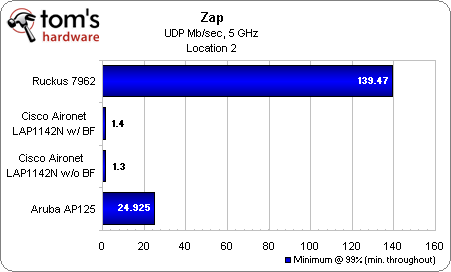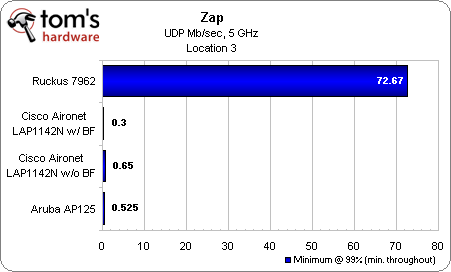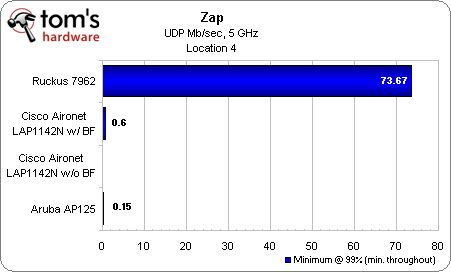Beamforming: The Best WiFi You’ve Never Seen
Zap At 2.4 And 5 GHz, Minimum
For all you video buffs, we come to the critical 99% Zap tests. We nearly decided not to include these results in this article because they’re so ridiculously one-sided. Even still, there are some (disappointing) surprises here.
Right off the bat, the big question: What on Earth happened to Cisco? How do you have 1 Mbps performance pockets at arm’s length? Aruba didn’t. Ruckus sure didn’t. This is embarrassing.
For the rest of our 2.4 GHz 99% tests, Aruba gives up its fleeting advantage, joining Cisco at the 1 Mbps pity party. But at least nobody lost a connection. That’s something.
When we switch over to the 5 GHz band, there’s more oddness. Ruckus exhibits none of the location 1 black holes found with Aruba and Cisco. Why? We’re not sure. This is much worse from Aruba and Cisco than I expected. So I grabbed the trusty Wi-Spy Spectrum Analyzer to scan location 1 for interference.
Wi-Spy results showed nothing out of the ordinary. In fact, the conclusion that both of the Aruba and Cisco products are unusable for video streaming is inescapable, although not unexpected. Actually, these results are typical for 802.11n products, which is why you haven’t seen many carriers or manufacturers marketing WiFi for video. Yes, there are a few exceptions, but the proof is in the pudding, not the PR. It’s simply been impossible to sustain a quality experience. Once more, recall my shock at the beginning of this piece.
Get Tom's Hardware's best news and in-depth reviews, straight to your inbox.
Current page: Zap At 2.4 And 5 GHz, Minimum
Prev Page Zap In 5 GHz, Average Next Page Chariot At 2.4 GHz-
pirateboy just what we need, more retarded failnoobs clogging up the airwaves with useless braindead movieclips...yaayReply -
bucifer This article started up pretty good with lots of technical data and the beamforming technology in theory but after that the goodness stopped.Reply
1.You cannot compare two products by testing them with a in-house developed software. It's like testing ATI vs nVIDIA with nvidia made benchmark.
2.If you do something get it done, don't just go with half measures. I don't care if you didn't have time. You should have planned this from the beginning. The tests are incomplete, and the article is filled with crap of Rukus and Cisco. -
Mr_Man In defense of your wife, you didn't HAVE to use that particular channel to view all the "detail".Reply -
@Mr_Man: With a name like yours, I'd think that you'd sympathize with Chris a bit more :P Unless (Mr_Man == I likes men) :DReply
-
Pei-chen Both Tyra and Heidi have personal issues and would be pretty difficult friend/mate.Reply
The network idea sounds better. I couldn’t get my 10 feet g network to transmit a tenth as much as my wired network without it dropping.
-
zak_mckraken There's one question that I think was not covered by the article. Can a beamformaing AP can sustain the above numbers on two different clients? Let's say we take the UDP test at 5 GHz. The result shows 7.3 Mb/s. If we had two clients at opposite sides of the AP doing the same test, would we have 7.3 Mb/s for each test or would the bandwidth be sliced in 2?Reply
The numbers so far are astonishing, but are they realistic in a multi-client environnement? That's something I'd like to know!
